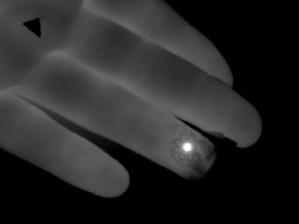New Wearable Device Can Measure Your Blood Flow
How much blood is running through your veins, arteries, and capillaries? To find out, you’d typically need to be motionless. Now a new wearable device may soon be able to give you that information even while you’re moving around, doing normal activities. The flexible patch, which conforms to the skin and uses tiny heat sensors to precisely map the blood flow beneath the surface, could give doctors a high-resolution view of this important indicator of health.

The inventors of the new “epidermal electronic” sensor system say it is ready for use in a clinical setting, specifically for monitoring skin health, for example in patients who have recently had skin grafts. They say down the road it may also be possible to use it inside the body. In a recent demonstration, the researchers showed that the device can record accurate data from human subjects about the flow of blood in larger vessels, specifically veins in the forearm, as well as in the network of tiny vessels near the surface of the skin.
Compared with state-of-the-art methods for noninvasively measuring blood flow, which rely on optical systems or ultrasound technology, the new sensor is much simpler and less expensive, says John Rogers, one of the inventors and a professor of materials science and engineering at the University of Illinois at Urbana-Champaign. More importantly, he says, it is much less sensitive to motion thanks to the way it “intimately laminates” to the skin.
Characteristics of the blood flow in any given tissue are a good indicator of that tissue’s health. Some conditions, like infection and inflammation, can lead to an increase in local blood flow, whereas others, like atherosclerosis, heart failure, and diabetes, can cause a decrease. If doctors could precisely and even continuously monitor this flow, they could better tailor care to individual patients and conditions.
Rogers and his colleagues have been developing epidermal electronic monitoring systems, which they make via established microfabrication techniques, for several years (see “Making Stretchable Electronics”). The blood flow sensing system represents the most sophisticated application of the technology yet.
The device works by imperceptibly heating up the skin and then recording the movement of that heat. Imagine, for example, that the heating element is positioned over an artery or vein near the skin’s surface. After the device heats the skin, the blood in that vessel carries the heat away, and then temperature sensors, arranged in rings around the heating element, record the direction and amount of the heat as it moves. By combining that information with models that account for the fluid dynamics of blood flow, “you can quantitatively determine flow rate,” says Rogers.
Rogers says he and and his colleagues are “moving immediately” to use the technology to monitor wound healing in studies of how vascularization happens in skin grafts. Additionally, the cosmetics company L’Oréal, which helped fund the research, has begun manufacturing the devices and has developed software that automates the data analysis and features a graphical user interface. Rogers says dermatologists that do clinical research for L’Oréal are now using it to study skin health.
At this point the system can only sense at a depth of up to two millimeters, but the group is looking at different ways of configuring the sensors and heating element that might allow them to sense at a greater depth. The same technology could also be used on surgical tools or implants for measuring internal blood flow.
Deep Dive
Humans and technology
Building a more reliable supply chain
Rapidly advancing technologies are building the modern supply chain, making transparent, collaborative, and data-driven systems a reality.
Building a data-driven health-care ecosystem
Harnessing data to improve the equity, affordability, and quality of the health care system.
Let’s not make the same mistakes with AI that we made with social media
Social media’s unregulated evolution over the past decade holds a lot of lessons that apply directly to AI companies and technologies.
Stay connected
Get the latest updates from
MIT Technology Review
Discover special offers, top stories, upcoming events, and more.